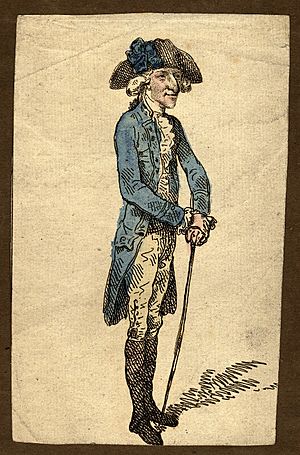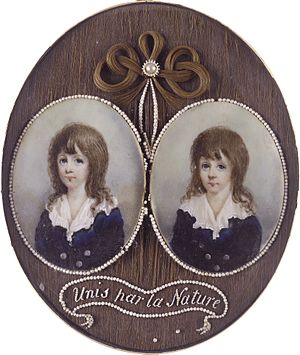John Toler, 1st Earl of Norbury facts for kids
Quick facts for kids
The Earl of Norbury
PC, KC
|
|
|---|---|
 |
|
| Chief Justice of the Irish Common Pleas | |
| In office 1800–1827 |
|
| Monarch | George III George IV |
| Preceded by | The Viscount Carleton |
| Succeeded by | William Plunket, 1st Baron Plunket |
| Personal details | |
| Born | 3 December 1745 Beechwood, County Tipperary |
| Died | 27 July 1831 Great Denmark Street, Dublin |
| Nationality | Irish |
| Spouse | Grace Graham (d. 1827) |
| Alma mater | Trinity College Dublin |
John Toler, 1st Earl of Norbury (born 3 December 1745 – died 27 July 1831) was an important Irish lawyer, politician, and judge. He was also known as The Lord Norbury from 1800 to 1827. During his time, he was a very talked-about person. Some people called him the "Hanging Judge" because of his strict rulings. He served as the Chief Justice of the Irish Common Pleas from 1800 to 1827.
Contents
Early Life and School
John Toler was born in Beechwood, near Nenagh, in County Tipperary, Ireland. He was the youngest son of Daniel Toler, who was a Member of Parliament. His older brother, Daniel Toler, also became a politician. The Toler family originally came from Norfolk, England. They moved to County Tipperary in the 1600s.
John went to school at Kilkenny College. Later, he studied at Trinity College Dublin. He lived in Cabragh House in Dublin and also had a home at 3 Great Denmark Street in Dublin.
Career in Law and Politics (1770-1800)
After finishing university, John Toler decided to become a lawyer. He officially became a lawyer in Ireland in 1770. In 1781, he was made a King's Counsel, which is a special title for experienced lawyers.
Toler also entered politics. He was elected to the Irish Parliament for Tralee in 1773. He held this seat until 1780. Later, he represented Philipstown from 1783 to 1790. He then represented Gorey from 1790 until 1801. This was when the Act of Union joined the parliaments of Ireland and Great Britain.
In 1789, he became the Solicitor-General for Ireland. He held this job until 1798. Then, he was promoted to Attorney-General for Ireland. In this role, he was in charge of prosecuting people involved in the Irish Rebellion of 1798. He was known for being very firm during these trials. In 1799, he helped pass a law. This law allowed the Lord Lieutenant of Ireland to suspend certain rights and use martial law (military rule).
Chief Justice of the Irish Common Pleas (1800-1827)
In 1800, John Toler was appointed Chief Justice of the Irish Common Pleas. This was a very important position. At the same time, he was given the title Baron Norbury. This made him a member of the Peerage of Ireland.
His appointment as a judge was quite controversial. Some people thought he was not the best choice for such a high legal role. He served as Chief Justice for 27 years. During this time, he became known for his strict approach and sometimes his jokes in court. This earned him the nickname "Hanging Judge." He was seen as a very influential figure in the Irish government.
One of his most famous trials was that of Robert Emmet, an Irish Republican leader. Norbury was known for interrupting Emmet during the trial. Despite the criticism, he strongly believed in the Protestant ascendancy. This was a system where Protestants held most of the power in Ireland.
Over time, Norbury's position became difficult to maintain. The British government wanted to improve relations with the Catholic majority in Ireland. In 1822, a letter written to Norbury by William Saurin, the Attorney-General, was found. In the letter, Saurin asked Norbury to influence juries against Catholics. This caused a scandal.
Daniel O'Connell, a famous Irish political leader, strongly opposed Norbury. O'Connell brought up the case of Saurin's letter in the British Parliament. O'Connell also tried to have Norbury removed in 1825. He claimed Norbury fell asleep during a murder trial and couldn't remember the evidence.
Finally, in 1827, when George Canning became Prime Minister, Norbury was persuaded to resign. He was 82 years old at the time. As a reward for his resignation, he was given new titles: Viscount Glandine and Earl of Norbury. These new titles could be passed down to his second son, Hector John.
Family Life

Lord Norbury married Grace Graham in 1778. They had two sons and two daughters. In 1797, Grace was also given a noble title, Baroness Norwood. This was done to honor her husband.
Grace died in 1822. Her eldest son, Daniel, inherited her title. Lord Norbury lived for nine more years after his wife. He passed away at his home in Dublin in July 1831, at the age of 85. His eldest son, Daniel, inherited his barony of Norbury. His second son, Hector, inherited the viscountcy and earldom. In 1832, Hector also inherited the other titles after his older brother Daniel passed away.

